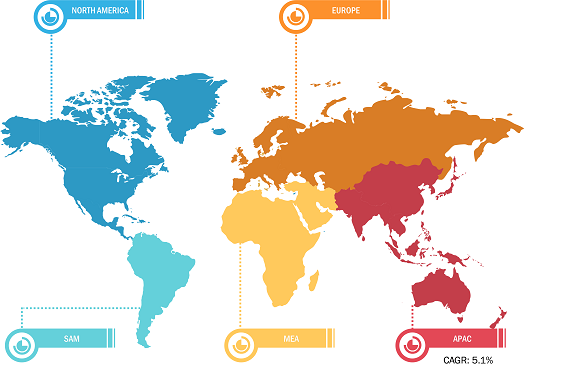
Biomass Pellets Market
In 2022, Europe held the largest global biomass pellets market share. According to a report published by the United States Department of Agriculture in 2022, the consumption of wood pellets in the EU is rising due to the growing residential applications in Germany and co-firing of wood pellets in the Netherlands. The report revealed that the production of wood pellets in the EU27 increased from 18.67 million metric tons in 2019 to 19.70 million metric tons in 2021. The major consumers of wood pellets in the EU are Italy, the Netherlands, Germany, Denmark, France, Sweden, Belgium, and Austria. In 2021, the consumption of biomass pellets in Europe grew due to rising prices of fossil fuel and natural gas. The demand for wood pellets in the Netherlands, Denmark, and Belgium was driven by the rising use of pellets in power plants. The increasing consumption of biomass pellets in Europe is broadly supported by programs pertaining to biomass pellets appliances by governments of several European countries, such as Austria, Belgium, and France. All these factors are driving the biomass pellets market growth.
Increasing Utilization of Agricultural Residues for Biomass Pellets Production
Biomass pellets produced from agricultural residues have been gaining popularity as a sustainable approach for biomass energy production. The production of agricultural residues is directly associated with the largest agricultural regions across the globe. The high availability of agricultural residues creates a scope for promising feedstock for biomass pellets production. Further, the utilization of agricultural residues aids in waste management issues and minimizes the need for incineration activities. The production and sale of value-added products derived from agri-wastes also offer scope for the monetization of waste material. Governments and regulatory authorities worldwide have set targets to support energy security and climate change mitigation. According to the United States Department of Agriculture, there is a growing popularity of using forest and agricultural residues for pellet production. Therefore, increasing utilization of agricultural residues for biomass pellets production is expected to create lucrative opportunities in the biomass pellets market growth during the forecast period.

Biomass Pellets Market: Segmental Overview
Based on source, the biomass pellets market is segmented into agricultural residue, industrial waste, wood, and others. The biomass pellets market share for the wood segment was recorded to be the largest in 2022. The agricultural residue segment is expected to record the highest CAGR from 2022 to 2030. Pellets produced from agricultural biomass have high energy content owing to their dense composition. Agricultural residue offers several environmental advantages and reduces dependency on fossil fuels. It includes crop straws, wheat straws, cotton, stalks, bamboo dust, tea waste, corn stalks, nutshell, bagasse, and other agricultural by-products. The utilization of agricultural residue in the production of biomass pellets aids in agricultural waste management and minimizes pollution due to waste incineration.
Based on application, the biomass pellets market is segmented into power plants, industrial heating, residential and commercial heating, and others. The biomass pellets market share for the power plants segment was recorded to be the largest in 2022. Biomass pellets are widely used in power plants to generate electricity. It is also used in biomass power plants and co-firing coal power plants. Co-firing involves blending biomass pellets with coal through direct mixing or a separate feeding system. Biomass pellets in power plants offer several environmental benefits, such as renewable energy sources, reduced greenhouse gas emissions, and waste management.
Impact of COVID-19 Pandemic on Biomass Pellets Market
Before the onset of the COVID-19 pandemic, the biomass pellets market was mainly driven by increasing use of biomass pellets in power generation as well as for heating applications in residential, commercial, and industrial sectors. However, due to the pandemic, governments of various countries across the globe imposed country-wide lockdowns that directly impacted the growth of the industrial sector. The shutdown of production facilities negatively impacted the biomass pellets market growth in 2020. The shortages in the supply chain of biomass pellets resulted in increased costs of biomass pellets in different regions. However, with the ease of lockdown measures, the various industries regained momentum, which increased the demand for biomass pellets. Further, various economies began reviving with the resumption of operations in different sectors in 2021. As a result, the biomass pellets market is also growing with the rise in demand from various sectors.
Biomass Pellets Market: Competitive Landscape and Key Developments
A few players operating in the global biomass pellets market include Drax Group Plc, Enviva Inc, AS Graanul Invest, Lignetics Inc, Valfei Products Inc, Mallard Creek Inc, Energex American Inc., Wismar Pellets GmbH, UAB Redal Ltd, and Premium Pellet Ltd. Players operating in the global biomass pellets market focus on providing high-quality products to fulfill customer demand.
Key Developments
- In September 2022, Enviva Inc inaugurated its newly constructed wood pellet manufacturing facility in George County, Mississippi (US). The plant started production activities at the beginning of 2022 to reach an annual permitted production capacity of 750,000 metric ton per year (MTPY).
- In April 2022, Drax Group PLC opened a new pellet plant at Demopolis in Alabama, the US. The plant produces sustainable biomass pellets annually from sawmill residues such as sawdust, chips, and shavings.
- In December 2020, Pure Biofuel Ltd. launched ENPOWER wood pellets. ENPOWER wood pellets bags incorporate A1 quality standards, which are set out by the UK Pellet Council and the European Council. This product is available in 10-kg or 15-kg packets.
- In April 2021, Drax Group PLC acquired Pinnacle Renewable Energy Inc. With the acquisition, Drax Group PLC delivered bioenergy with carbon capture and storage (BECCS), permanently removing carbon dioxide from the atmosphere yearly.






